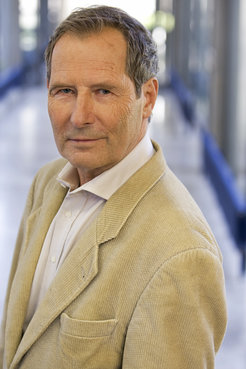Bavarian Maximilian Order for Dieter Oesterhelt
Dieter Oesterhelt, Emeritus Group Leader at the Max Planck Institute of Biochemistry in Martinsried, has been awarded the Bavarian Maximilian Order for Science and Art.

The chemist Dieter Oesterhelt, born in Munich in 1940, was and still is deeply rooted in the city. His research career began in the laboratory of the Nobel laureate Feodor Lynen at the Max Planck Institute of Cell Chemistry in Munich. The subject of his doctoral thesis on fatty acid synthetase in yeasts led him to the University of California in San Francisco for a research residency under Walter Stoeckeniu (1969). There he encountered the archaebacterium Halobacterium salinarum and the question of why it appears purple in the dark and yellow in the light. After his habilitation in 1975, Oesterhelt worked at the Friedrich Miescher Laboratory in Tübingen, and in 1976 he was granted a professorship at the University of Würzburg. In 1980 his career led him back to Munich to work at the Max Planck Institute of Biochemistry, which was founded in 1973.
He headed the Membrane Biochemistry Department for 28 years until 2008 and has since continued his work at the Institute as Emeritus Group Leader. During this time he showed that the bacteriorhodopsin he discovered is a light-driven proton pump located in the membrane of the archaebacterium. He called the new molecule bacteriorhodopsin, as one of its components, retinal, was already known to be a pigment of rhodopsin, the visual pigment in the human eye.
“The principle is comparable to that of a hydroelectric power plant. Water is pumped up a mountain so that it can flow back into the valley, driving an electric generator in the process,” Oesterhelt explains. In the cell, instead of water, protons are pumped out of the cell through a membrane with light. Rather than a difference in altitude between a mountaintop and a valley, there is an electrical potential between the inside and the outside of the cell. The cell uses the energy that is released when the protons flow back into the cell to make ATP, an energy-rich biomolecule and the main energy currency of cells.
In the course of years of painstaking work, Oesterhelt and his staff unravelled how Halobacterium uses light as an energy source to operate a simple form of photosynthesis. He was the first to succeed in breeding crystals of bacteriorhodopsin, which he used to determine the chemical and spatial structure of the protein. The methods they developed still form the basis for the structural analysis of membrane proteins.
The scientists also succeeded in specifically altering the properties of bacteriorhodopsin. By replacing single amino acids, they obtained molecules that react to light of different wavelengths. This formed the cornerstone of a new research field, optogenetics, in which, specific rhodopsins are introduced into cells that can be electrically stimulated, such as muscle or nerve cells. The cells can then be selectively switched on and off (via ionic influx and outflow) by exposing them to light of various wavelengths. This opens up numerous opportunities to investigate the function of the brain and perhaps some day to cure certain brain diseases.
Now 76, Oesterhelt still feels the urge to discover. Together with his colleague Norbert Hampp from Marburg, he has been concerned for many years with the potential technical applications of biotechnologically modified variants of bacteriorhodopsin. Variants of bacteriorhodopsin can be used, for example, as an optical data medium or safety pigment. When exposed to light, the molecule changes from purple to yellow. Documents prepared with inks containing bacteriorhodopsin undergo irreversible bleaching when exposed to light – providing proof of their authenticity. At the same time, fading of the ink prevents copying, as the light of a photocopier or scanner causes the ink to change colour.
Except for a brief interlude, Oesterhelt has conducted his research in Bavaria. “I think Munich is the most beautiful city in the world and I’m grateful that I’ve always had the opportunity to pursue my passion, research, here.”
Awards and honours
Dieter Oesterhelt has already won numerous awards in the past. For example, in 1991 he received the Otto Warburg Medal, in 1993 the Gregor Mendel Medal, in 2004 the German Order of Merit First Class, and in 2010 the Science Award of the Donors’ Association for the Promotion of Humanities and Sciences in Germany.












